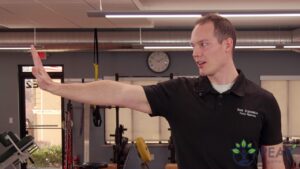Easy Nerve Glides | Early Intervention Ergonomics
What are Easy Nerve Glides?
Nerve glides, also known as neural glides or nerve flossing, are exercises that help mobilize and stretch the nerves in the body. Nerve glides floss the median nerve in the carpal tunnel and promote healthy neural tension of the nervous system. This composite stretch originates at the nerve roots in the brachial plexus and pulls all the way down to the median nerve that passes through the carpal tunnel. Perform this stretch to give your body rest when performing forceful gripping, repetitive gripping, awkward or sustained postures of the elbow, forearm, wrist, and hand to prevent carpal tunnel syndrome. They can be beneficial for individuals experiencing nerve-related pain, tingling, or numbness. Here is how to perform easy nerve glides:
- Starting with the right side, bend at the elbow and bend at the wrist like you are holding a baby.
- Next, slowly glide your arm out and up with your palm facing away as if you are stopping a car.
- Repeat again with “hold the baby” and “stop the car.”
- Each stretch should take 3-5 seconds
- Repeat on the left side.
Early Intervention Benefits
Performing nerve glides offers several early intervention benefits, including improved nerve mobility, reduced pain, enhanced circulation, and injury prevention.
Firstly, engaging in nerve glides helps improve nerve mobility. By gently moving and stretching the nerves, these exercises promote healthy nerve gliding, preventing them from becoming compressed or stuck. This improved mobility can alleviate symptoms such as pain, tingling, and numbness associated with nerve entrapment or irritation.
Moreover, nerve glides can help reduce pain. The controlled movements involved in nerve glide exercises can stimulate the release of endorphins, the body’s natural pain-relieving chemicals. Additionally, by promoting proper nerve function and reducing nerve compression, these exercises can alleviate discomfort caused by conditions like carpal tunnel syndrome, sciatica, or brachial plexopathy.
Furthermore, nerve glides contribute to enhanced circulation. As the nerves are gently stretched and mobilized, blood flow to the surrounding tissues increases. Improved circulation delivers essential nutrients and oxygen to the nerves, aiding in their healing and overall health.
In addition to the aforementioned benefits, performing nerve glides can also play a preventive role in injury management. By maintaining optimal nerve mobility, individuals are less prone to developing chronic nerve-related conditions or experiencing further injury. Regularly incorporating these exercises into a comprehensive rehabilitation or wellness routine can help safeguard against future nerve entrapments or injuries.
Things to Remember
Remember, it’s crucial to perform nerve glide exercises gently and within your comfort level. If you experience increased pain or discomfort during the exercises, it’s best to stop immediately and consult with a healthcare professional.
These stretching exercises are to improve overall health & fitness as well as reduce work-related injuries.
If you have an injury or illness, consult with a health care professional before attempting.
Contact us for more information on how we can help your employees stay safe. Healthy Employees ARE the Bottom Line!
More Tools & Resources from Peak Ergonomics
Contact Us About Reducing Workplace Injuries
Healthy Employees are the Bottom Line! – Learn More!

